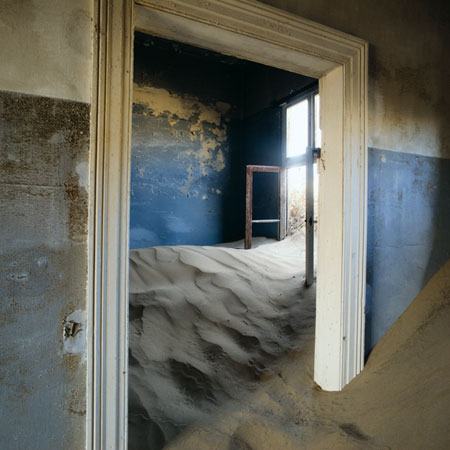|

What does the word earth mean to you? Clay? Sand? How about salt? Does your definition include the cities that increasingly sprawl across our planet's surface?
Across the vast African continent, artists have found inspiration in the earth's mud, pigments, plants, stone, ash, and incredibly diverse resources. These materials have been used to express personal or cultural identity, provide connections to the generations who have walked the land before us, build fantastic structures, and imagine what we have lost to time. The ideas and arts inspired by the earth are as diverse as the materials this planet and its land provide.
|

Andrew Putter
b. 1965, South Africa
Hottentots Holland: Flora Capensis 2
2008
Archival pigment ink on cotton rag paper
Photography and compositing: Tony Meintjes
Flower arranging: Christopher Peter
Courtesy Michael Stevenson Gallery
Products of the earth. History and memory meet among the flowers surrounding Cape Town for artist Andrew Putter. He has spent years scouring his native landscape to find rare snails, butterflies, and flora that were indigenous to the South African cape before the Dutch arrived in 1652 and began calling the local population "Hottentots." Arranged like a Dutch still life, every feature-right down to the wood vessel replacing a vase-could also have been enjoyed by the Khoikhoi who preceded the artist on the land and, as he says, "gives me a focus for my attempts to connect with them."
|
Yombe artist, Democratic Republic of the Congo, Angola, and Republic of the Congo
Nkisi nkondi (power object)
19th century
African teak (Chlorophora excels), metal, feathers, pigments, earth, glass, textiles, mirror, claws
Musée royale de l'Afrique centrale, Tervuren, Belgium EO.0.0.22438
The colors of the earth. Kongo earth is not the dull brown of dust or dirt, but the rich red of blood, the shimmering white of water and reflective surfaces, and the deep black of decay and organic processes. Each of these symbolic colors and their earthen associations can be found in this affecting power figure that once overcame the obstacles and opponents of its users.
|
Berni Searle
b. 1964, South Africa
Seeking Refuge
2008
Streaming video (5 min. 51 sec)
Edition of 5 + 2 artist's proofs
Courtesy Michael Stevenson Gallery
Touching the earth. Berni Searle filmed herself moving across the dramatic terrain of Lanzarote Island in this poignant exploration of immigration. Her feet touch surf, salt, sand, and stone and make us question what is lost and what we seek in a landscape.
|

Jide Alakija
b. 1977, England
Invisible Cities #1 (Bombay)
2008 (2013 exhibition print)
Fuji crystal archival print
Courtesy Tafeta and Partners
The urban earth. Ramshackle shelters are propped on stilts above inky, stagnant waters in Jide Alakija's photograph. Taken in Lagos, Nigeria, but entitled Bombay, this photograph could portray anywhere and testifies to the degree to which we have begun to associate the earth and its surface with cities and urban sprawl.
|

Helga Kohl
b. 1943, Germany
Family Accommodation/Portfolio Kolmanskop
1994 (2013 exhibition print)
Photograph (Agfa RSX 50 slide film)
Collection of the artist
Sands of time. A town once thrived around the diamond mines of Kolmanskop, Namibia, but when its riches were exhausted, its residents abandoned their homes, hospital, offices, and shops. These structures are slowly being returned to the earth as the surrounding sands swallow them. Returning repeatedly to this ghost town, photographer Helga Kohl commented (2007), "I transformed myself into the past, and in so doing saw a life which somehow brought profound understanding to the present. . . . One day I knew I was ready to capture the beauty once created by people and taken over by nature."
|

Kurumba artist, Burkina Faso
Storage vessel
Mid-20th century
Ceramic
National Museum of African Art, gift of Saul Bellow, 81-10-1
Fired earth. The fired earth of this hand-built vessel speaks to the transformative capabilities of clay, the life-giving role of earth and women, and the extraordinary skill of the unknown woman who made it. Its raised patterns recall the scarification marks once adopted by Kurumba women, for just as a woman's body can sustain life, so too did the millet, sorghum, and other grains that it once stored.
|
|
|





